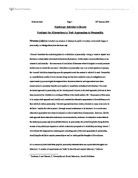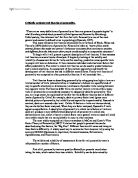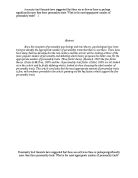The first approach being the single trait approach that converges on one particular personality trait that may explain important behaviours. Any single trait scale must be satisfactory wit respect to three essential criteria: reliability, stability and validity. This method is however, unsuitable for describing an acceptable model of personality, as it is only a collection of traits. This leads to the second method which is the many-trait approach, known as the factor analysis, which, using many traits (estimated to be at around 20000), identifies many dimensions of personality and associate these with certain behavioural characteristics e.g. the California Q-set. The final method is the essential trait approach that recognises the few fundamental traits that are essential to understanding personality and its individual differences. Eysenck’s Three Factor model and the Big Five model are examples of studying the essential trait approach.
The trait approach to personality employs a great deal of empirical and scientific data that evolve theories based on fact as opposed to bias. This means that the theories have been conceived on an objective level. It is shown that numerous assessment devices have been created due to the easy use and understanding of the trait approach and therefore enable us to form comparisons between people and their behaviours. Critics of the essential trait approach have argued that ‘essential traits’ do not predict behaviour very well and state that a person’s behaviour is likely to be influenced by the environment in which they are in as to their personality traits. These critics are known as ‘situationists’ and this approach was conceived by Mischel (1968) who stated that situations are stronger predictors of behaviour. Another criticism of the trait approach was concerned with the many-trait method. Items in the Q-set, a self-monitoring analysis, and other personality inventories, ask people to report past or imagined behaviours. These behaviours are then used to predict future behaviours or other past behaviours. This therefore may say more about behavioural consistency over time than about personality. Due to the fact that the trait approach is of a statistical nature and not theory, it provides no insight to the important aspect of personality development, as shown by the Q-set.
Many personologists have devised alternative approaches to personality. They fall under several techniques: Biological, Psychoanalytical, Psychodynamic, Behavioural, Humanistic and Cognitive. At this point it is vital to identify and evaluate the predominant techniques due to the vast amount.
The biology technique can be divided into four main sub groups: brain anatomy, where anatomical factors which may influence personality are investigated, physiology of the nervous system, where biochemical factors which may influence personality are investigated, behavioural genetics, and evolutionary biology. Biological approaches are very closely related to the trait approach in that, a trait is measured (aggressiveness) and a physiological parameter is assessed (testosterone level). The two are then correlated. Research focus is mostly on the biological side of things, which tends to be investigated in more sophisticated ways as a result. For example, complex physiological measures are compared with simplistic indicators of personality (questionable self reports).
There are two main reasons as to why we should evaluate the biological approach. Firstly it has been believed by theorists for many years that our genetic make up somehow determines to some extent our personality and secondly it is often debated as to how much, if any, biology can influence developments in personality. Critiques to this technique believe that there is relatively little research and facts on biological aspects of personality. Biological factors are blunt instruments in our understanding of the complexity of human behaviour. They predict tendencies for broad behavioural/psychological clusters across large segments of the population. Biological approaches often tell us more about biology than about psychology and that human behaviour is best understood at the level of physiological factors. Again it is argued by some situationists that this technique underestimates the influence of situational factors and the environment in which the subject is placed. In its simplest form, biological components strongly determine our physical characteristics such as eye colour, height, hair colour, body type, and general looks. Even if biology plays no direct role in our personality, the way we look certainly affects how we see ourselves and how others interact with us. This indirect affect does, at minimum, play a role in how we develop and who we are as adults.
Trait approaches and biological approaches are all about the structure and determinants of personality. They are about outward form and its biological determinants. However, people may more often than not perceive their personality as to the meaning of how they act and think. Meaning is what is central in the approach of the psychoanalyst. Sigmund Freud is considered to be one of the main developers of the psychoanalysis approach. It must be stated at the beginning of the evaluation of this approach that Sigmund Freud’s approach derived from the influence of early childhood experiences. Freud was principally concerned with the unconscious, the part of the mind that is hidden from view and, in some cases, seemingly irrational, contradictory or absurd. The reason that the unconscious is so prominent in Freud’s theory is that the rational motives people give for their actions are almost always constructions—the real reasons for why we do the things we do are unconscious drives. Freud states that the instincts are the ultimate cause of all behaviour. Freud describes that there are two underlining basic instincts for every human, Eros (love) and the destructive or death instinct. The purpose of Eros is to establish and preserve unity through relationships whereas the purpose of the death instinct is to undo connections and unity via destruction. It is believed that these two basic instincts can either operate with or against each other. According to Freud, the mind is composed of three mental structures, known as the id, ego and superego. A fundamental attribute of psychoanalysis is that the basis for personality is the energy associated with basic biological drives or id. . The id functions by what is known, as the pleasure principle i.e. libidinal energy must be satisfied. The superego is a moral agent—it regulates our behavior to the needs and demands of society. The superego is formed through identification with the same-sex parent, and it is able to exercise control by inducing anxiety and guilt. Selfish needs and societal boundaries desired by the id and superego are often incompatible and is therefore the responsibility of the ego to make compromises. The ego is responsible for our conscious and deliberative behavior: it plans, thinks, and thereby controls the id. The development of humans has been classified into certain stages in order to understand how personality may develop and give reasons as to why childhood experiences may affect personality. The stages are know as the oral phase (1), the anal stage (2-3), Oedipal/Phallic Stage (4-6) and then finally the genital stage (12-18). During the oral phase, the individual places emphasis on providing satisfaction for the needs of the mouth, which emerges as the first erotogenic zone. During the sadistic-anal phase, satisfaction is sought through aggression and in the excretory function. During the phallic phase, the young boy enters the Oedipus phase where he fears his father and castration while simultaneously fantasizing about sexual relations with his mother. The young girl, in contrast, enters the Electra phase, where she experiences penis envy, which often culminates in her turning away from sexual life altogether. Following the phallic phase is a period of latency, in which sexual development comes to a halt. Finally, in the genital phase, the sexual function is completely organized and the coordination of sexual urge towards pleasure is completed.
Freud and his approach invite much criticism, however it is evident that Freud’s approach has had great influence to the study of personality so far and is thought to provide one of the most comprehensive accounts of human nature. Like trait approaches to personality Freud’s theories have received empirical support relating to the personality types derived from the stages of childhood e.g. in the anal phase the themes are obedience and self-control and hence people with a fixation in this phase are thought to be obsessively tidy and orderly, or extremely disorderly. However, one of Freud’s main weaknesses is said to be that of bias. It is believed that Freud’s theory is based his own life, especially referring to the relationship Freud had with his mother and his sexist views (Freud views women as castrated males), and therefore evokes speculation that his theories are not suitable to apply to a wider spectrum of people.
This essay has identified and evaluated both the trait approach to personality and the more predominant alternatives. It is evident that there is huge difficulty in assessing and concluding to which approach defines and describes personality most accurately. Each approach has evidence as well as having many reputable personologists to support their argument. As stated in the introduction the definition of personality can be perceived in many ways according to the chosen perspective and context in which it is viewed upon, therefore it is hard to define a specific approach that will encompass the universal definition of personality. Each technique offers advantages and disadvantages. Epstein (1996) argues that the trait theory is not sufficient either to account for differences in behavior in different situations, or to capture the complex uniqueness of individual identities. Mischel, who states that the underlying assumption of the approach may be untrue, backs up this critique: people may have such dynamic personalities that they do not possess trait-like characteristics. Mischel also claims that there should be a high correlation between scores on a trait measure for a subject and performance in a situation where that trait is evoked. However, according to Mischel, the correlation is extremely low. Mischel further argues that knowing a person's "traits" does not help predict their behaviour and measures of the same trait do not correlate highly with one another. Freud's relationship with his mother, Adler's childhood illness, or Jung's belief in mythology could be said to have influenced their theories. In that sense, subjectivity may have biased their ideas. The evidence of convergence between the trait approach and the psychoanalytical approach, evident in the use of empirical data, the Big Five Model and many more, may suggest a more overall approach to personality that incorporates many contexts and perspectives and therefore it could be debated that this combination is the strongest approach to personality. Although each approach has completely different answers to the question what makes people do what they do, they are all theories that try to make sense of human nature.
Reference:
Mathews, G and Deary, I, Personality Traits, Cambridge University Press
Furnham, A and Heaven, P, Personality and Social Behaviour, Arnold Publishers
Slater, A and Bremner, G, An Itroduction to Developmental Psycology, Blackwell Publishing
Ryckman, R, Theories of Personality, Brookes/Cole Publishing
http://www.psychology.org/
Furnham, A and Heaven, P, Personality and Social Behaviour, Arnold Publishers
Mathews, G and Deary, I, Personality Traits, Cambridge University Press
Mathews, G and Deary, I, Personality Traits, Cambridge University Press
Furnham, A and Heaven, P, Personality and Social Behaviour, Arnold Publishers
Mathews, G and Deary, I, Personality Traits, Cambridge University Press








